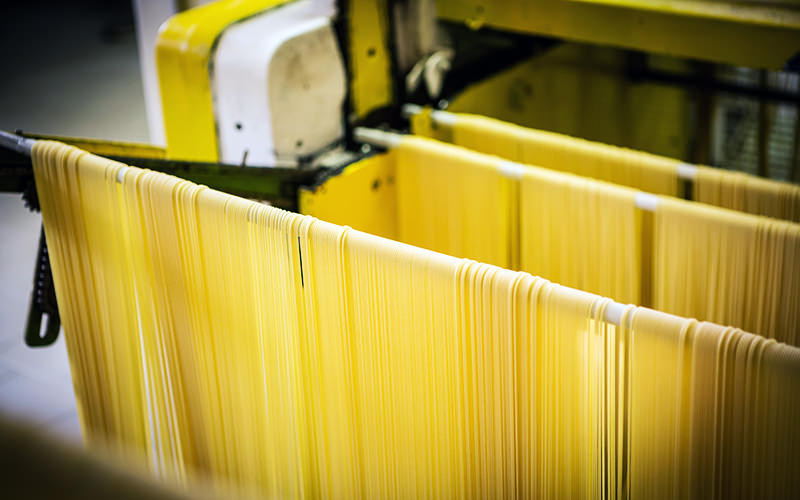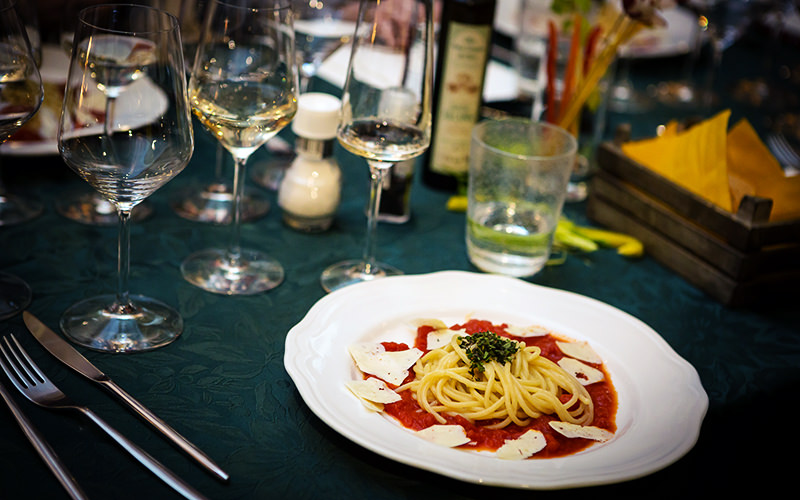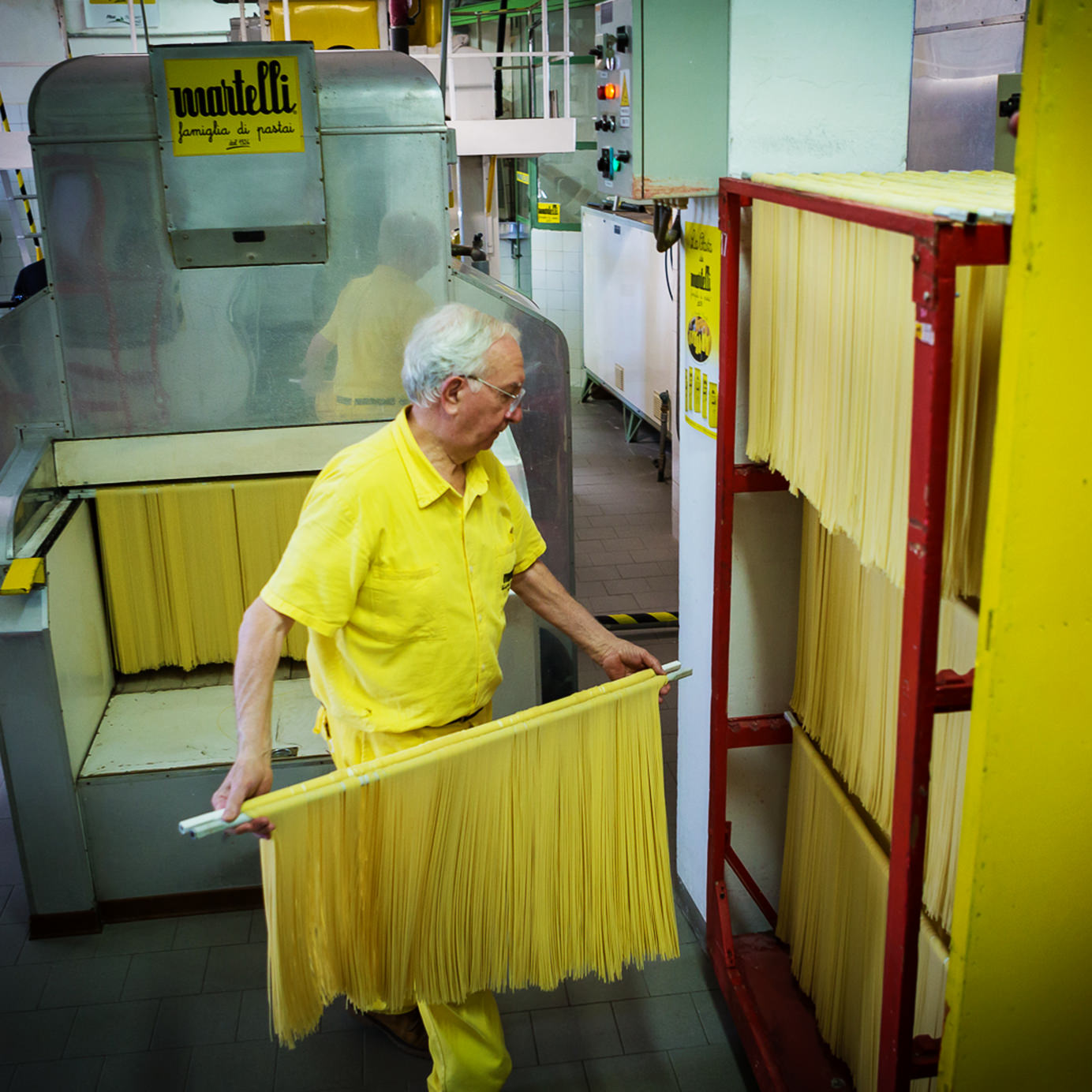
PSA: It’s time to stop eating big-brand, commercial pasta. It’s tempting to stand in front of the wall of brands and shapes and colors in the grocery store pasta aisle, stocking the pantry while the 5 for $5 special is on, but trust us – there’s a better way! In the same way that vegetables and fruit from small, local farmers taste remarkably better than generic produce, artisanal pasta from Italy is an echelon above the cheap commercial stuff. It’s time to up that pasta game.
The Martelli factory, unmissable with its bright yellow facade in the small hilltop town of Lari, may at first be disappointing to those with storybook visions of an artisanal, family-owned Tuscan pastaria. Rather than a kindly grandma rolling singular strands of pasta while chatting away in rapid Italian, there is an unromantic (and quite noisy) machine churning out weaves of spaghetti on a belt. But the operation is family owned. The two gents tasked with monitoring the machine are in fact father and son; the woman who rushes in to take over when the son begins to tell the family’s story, dressed in the family’s signature yellow, is his sister. The aforementioned pasta machine is actually the only machine in use, rather than the hundreds likely in operation at a commercial facility. In fact, what a commercial pasta facility makes in three hours is the equivalent of an entire year’s production for Martelli.
To put things further into perspective, Martelli only makes five shapes of dried pasta (spaghetti, spaghettini, penne, macaroni, and fusilli) comprised of two ingredients: semolina flour (which comes from southern Tuscany and northern Lazio) and water. Only family members work in the Martelli factory, and everything is packaged by hand, in this case by the aforementioned sister Laura, who weighs spaghetti by the kilo while pointing out the month’s orders (scribbled on a white board), showing where the pasta is sold (dots on a map poster), and teaching all about what makes artisanal pasta so special.

Need further proof that artisanal Italian pasta is the way to go? These five reasons are sure to convert you for good.
Authentic Italian pasta must be made from hard grains…
Is it really a surprise that Italy has laws governing the production of pasta? The first Italian pasta law was passed in 1967, and while it has changed over the years, one of its most important stipulations is that dried pasta made in Italy must be made with hard grain. Semolina flour made from durum wheat is most often used for dried pasta from Italy. Why is this important? Hard grains have more protein than soft grains (like all-purpose flour, for instance) and can absorb more water, making them hardier and less likely to fall apart, which is very important when shaping and cooking pasta.
While Italian-made commercial pastas are also held to these regulations for pasta made in Italy, many large pasta companies have manufacturing plants in other parts of the world and could technically use other kinds of wheat for these pastas. Barilla, for instance, makes much of their U.S.-bound pasta in Iowa and New York, though they insist that the recipe remains the same.
… And hard grain pasta is better for you
While hard grains are undeniably carbohydrates, durum wheat has a lower glycemic index than soft wheat. This essentially means that these “good carbs” aren’t converted into glucose as quickly, allowing a person’s blood sugar to remain steadier. In order to really get all of the grains’ health benefits, cook the pasta only until al dente — any more and the benefits will be lost. Hard grain pasta tastes better, too! Martelli’s pastas actually taste of rich, hearty wheat to complement pasta sauce.

Commercial pasta has a shorter drying time…
Dried pasta begins first as dough of flour and water, so the drying pasta is essential to the finished product. Most commercial pastas are dried for an average of 10 hours, boosted by high heat and a higher proportion of soft wheat. Martelli dries their pastas for around 50 hours in a warm, humid environment. Imagine what traipsing through a rainforest is like, and you’ve got a pretty good picture! It gives the grains plenty of time to rest.
… Which creates pasta that is harder to digest
When the drying process is sped up, the gluten in the pasta is put under intense pressure, according to the Martelli family. This stressed gluten is more difficult for the body to break down and digest, making it harsher. When the pasta is allowed to dry in a more natural way, the gluten is less stressed, and it is easier to digest, making it better for those with sensitivities to gluten.
Most commercial molds are made of teflon
Plastic teflon molds are more practical for industrial facilities, as they are lighter and easier to manufacture, but they create pasta that is completely smooth when dried and slippery-slimy when cooked. Artisanal pasta makers tend to use solid bronze molds, which create rough, textured pasta; the difference is noticeable even before the pasta is cooked. This texture is better for marrying with sauce, keeping it from sliding right off the noodles and creating a complete pasta dish.
